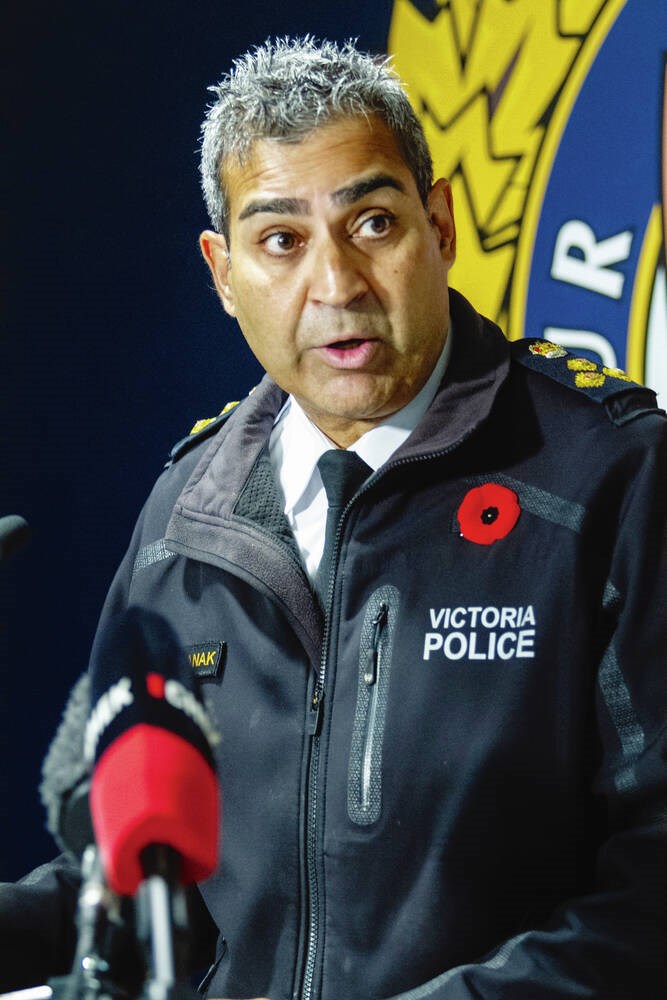VicPD is so desperate to put cops on the street that it has been reduced to begging Saanich officers to fill its shifts.
So, it wasn’t really a surprise Wednesday when the Victoria department announced it’s recalling all seven of its officers from the traffic, organized crime and national security units shared by departments throughout the capital region.
The move, effective Nov. 7, means there will be fewer officers chasing gangsters and drunk drivers.
That’s too bad, VicPD says, but the banged-up force needs those bodies back if it is to field the minimum number of frontline officers each day.
The seven will be shunted to the patrol division, where the department says there are so many injured officers and the volume, complexity and severity of calls is so high that the strain has become unsustainable.
VicPD says 39 of its 249 officers are currently unable to respond to calls for reasons that include physical and psychological injuries. Another 17 are recruits in the training pipeline.
“When citizens call for help, they expect that an officer will arrive to help them quickly,” Chief Del Manak said.
“Without this change and further changes, VicPD cannot maintain that basic level of service.”
Victoria Mayor Lisa Helps, who is also co-chair of the police board, backed Manak’s decision (which he said could be revisited next year). Patrol officers are “working too hard, without enough people on the ground,” she said.
She expects a majority of city council will support measures in next year’s police budget. Councillors from Victoria and Esquimalt will get their first look at the board’s proposal in a couple of weeks.
Now, the timing leads to the question of whether Manak is playing politics. VicPD accounts for almost a quarter of Victoria’s operating costs. It’s not unheard of for heads of taxpayer-funded agencies to put public pressure on politicians at budget time.
No, the chief insists, that’s not the case. He said police are overwhelmed and in crisis. “My officers are exhausted. They feel that there’s no hope.”
Look at the recent wave of physical attacks on police, such as the officer ambushed in a Vic West park.
Cops believe anti-police activism has emboldened hate.
Manak is so concerned about officers’ mental health that he just got the police board’s approval to contract a psychologist, a specialist in frontline trauma, to work with them.
Manak’s assessment was echoed by a retired officer, Andy Dunstan. Asked if he thought the chief is playing politics, Dunstan said no, ex-colleagues tell him the situation is as Manak describes it.
The intensity of the job, the physical and mental burden, is growing. “You’re getting your career’s worth of traumatic incidents much quicker,” said Dunstan, who left the force in 2018. “That’s going to have an effect on people.”
As is the case with COVID-slammed hospitals, the crisis worsens as over-stressed workers walk away from an over-stressed system.
“People are getting injured and not coming back,” Dunstan said. “Where do the reinforcements come from?”
The department has already cannibalized internal units to fill patrol spots. It reassigned six people, including three school-liaison officers, in 2018. In 2019, it made the controversial decision to disband its crime reduction unit.
Underlying all this is the fractured structure of policing in Greater Victoria, where resources, workload and costs are distributed unequally between four municipal forces and a few RCMP detachments. In lieu of the regional police forces common in the rest of Canada (save for the Lower Mainland) we have a patchwork of integrated units — Amalgamation Lite — doing specialized tasks on an area-wide basis.
At best, the integrated units are cumbersome to operate. Putting them together is like building a car with parts from half a dozen automakers. Different police forces have different cultures, record systems, computer programs, chains of command. They have to work out a million mundane details: whose cars will be used, who will house the unit, who buys the photocopier.
It doesn’t help that, as VicPD just showed, participation is voluntary, with departments having the ability to opt in and out. That’s what led to the collapse of the highly successful regional crime unit, which had a great record of catching prolific offenders, in 2014. Who would design a system where that happens?
“It makes no sense,” Helps said of the awkward structure. She hopes the province will address the fragmentation in its review of the Police Act.
But that’s for tomorrow. Right now, the police are just trying to get through today.



